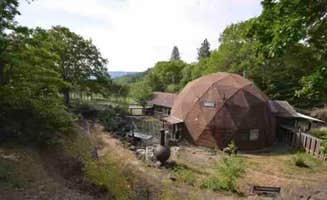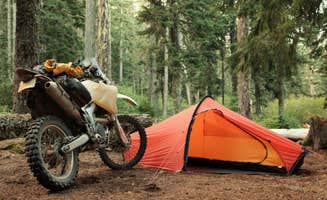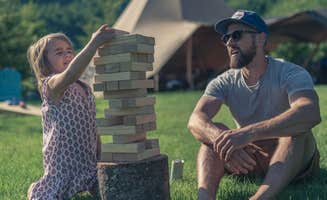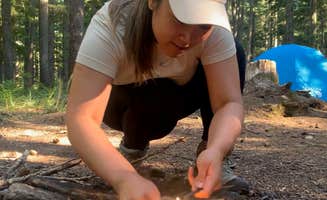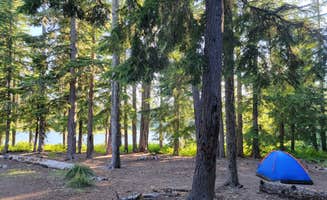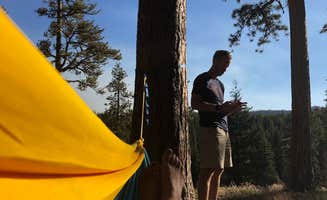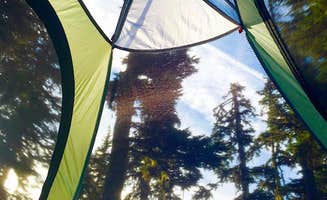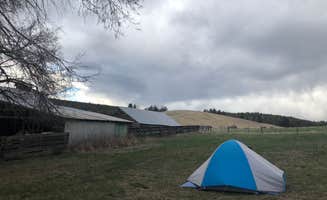Dispersed camping opportunities near Underwood, Washington extend beyond Panther Creek into several National Forest areas at elevations ranging from 1,200 to 3,500 feet. Summer temperatures typically reach 75-85°F during day and drop to 45-55°F at night. Winter access to many sites becomes limited after November due to snow accumulation on forest roads, particularly at higher elevations.
What to do
Fishing at alpine lakes: Goose Lake Campground offers excellent fishing opportunities in a non-motorized lake. "The fishing is excellent. Quiet campground. Easy access on forest road- some potholes," reports Brian B. Another camper added, "Nice spot. Has a boat launch, great sites to put up tents. Love fishing here."
Swimming in secluded water: Black Lake Campground provides access to a small mountain lake perfect for cooling off. "4 camp sites surrounding a small lake," notes Ryan D., who appreciated that "The best campsites are those that are not crowded and you can enjoy the stillness during the day or night."
Hiking nearby trails: Access multiple trail networks within 15-30 minutes of most camping areas. The trail to Rainy Lake takes less than 10 minutes and connects to longer routes. Sarah S. described her experience: "Behind sites 2 and 3 is the trailhead that will take you up to Rainy Lake. The hike was gorgeous with beautiful views of Mt. Hood."
What campers like
Lakeside privacy: Forlorn Lakes offers multiple small lakes with dedicated campsites. "All are lakeside on 'private lakes'. The only way to gain access to the lakes is through the campsites," explains Allison W. Campers at site 16 enjoy "lots of room for tents and two picnic tables for a large group. The private path to the lake was the best part."
Elevated views: Many dispersed sites provide unique vantage points. At Dispersed Camping above Panther Creek Falls, campers enjoy spectacular night skies. "We spent one night in that huge open area and it was beautiful - the stars were amazing," writes Sarah S. Ryan J. adds that the campsite is "overlooking the parking lot. It's a wide-open rocky area. Close enough to hear the falls."
Creek-side spots: Secluded sites along running water provide natural sound barriers. "Not too far from the nearest town but you will feel totally immersed out here," reports Alex R. about Panther Creek areas. "Ice cold creek, towering trees. Seemed to be lots of sites off the road to pick from."
What you should know
Road conditions: Forest roads vary significantly in quality. For Rainy Lake Campground, "The road getting up to Rainy Lake wasn't the greatest (but totally fine with a Subaru) so you have to drive a bit slow and look for potholes," notes Sarah S. At Forlorn Lakes, the advice is similar: "The road turns to gravel about 15 minutes before you reach the site and its pretty bumpy in some spots. Take it SLOWWW."
Seasonal insects: Mosquitoes become prevalent in summer months, especially near water. "Highly recommend yellow jacket traps this late in summer. Aggressive is an understatement," warns Michael H. Another visitor noted, "Visited in late June, and the weather was amazing, 15 degrees lower than in town, but the bugs and mosquitoes were overwhelming (even with deet)."
Campsite differences: Sites vary dramatically in privacy and amenities. At Goose Lake, "The campground is on a hill (but all the camping spots are flat) so you get a great view of the lake from most campsites," explains Sarah S. Similarly at Rainy Lake, "Site 1 was a little more blocked by 2 and 3 by a large log. 3 was a good site with enough level ground for 2 tents."
Tips for camping with families
Accessible water play: Several sites offer child-friendly water access. Trout Creek Campground features a year-round creek with approachable edges. "A quiet campsite set along Trout Lake Creek in a deeply wooded area," describes Chad L. Another camper shared, "You felt the creek was yours alone. Didn't want to leave!"
Considerate timing: Early or late season visits reduce crowds and bugs. "Quiet campground midweek, there was only a handful of other campers spread out throughout the campground," reports Megan A. "The day use area was clean and had a handful of different people fishing every day starting around 7-8."
Prepare for temperature shifts: Mountain elevations create significant day-night temperature differences. "The campground and day use area got windy everyday about 9-10 am and would last until sundown which made it a little chilly," notes one camper about lakeside camping in the region.
Tips from RVers
Size limitations: Most forest sites have restrictions for larger vehicles. At Columbia Gorge Getaways, Michael K. notes that despite size restrictions, "You can tell when the owners of a place like this really care. From being greeted by name as I pulled in to time spent talking with the owners under their lovely shared social hangout area with other campers."
Level site selection: Many forest campgrounds feature sloped terrain. At Goose Lake, one visitor noted, "Camp sites are a bit slanted on hillside," while recommending it for smaller rigs and trailers.
Dust management: Summer brings dry, dusty conditions on forest roads. "The biggest downside to camping here is the dust from the road. The lake is a popular spot so many people traffic the road and kick up a dust storm," warns Tom W.


